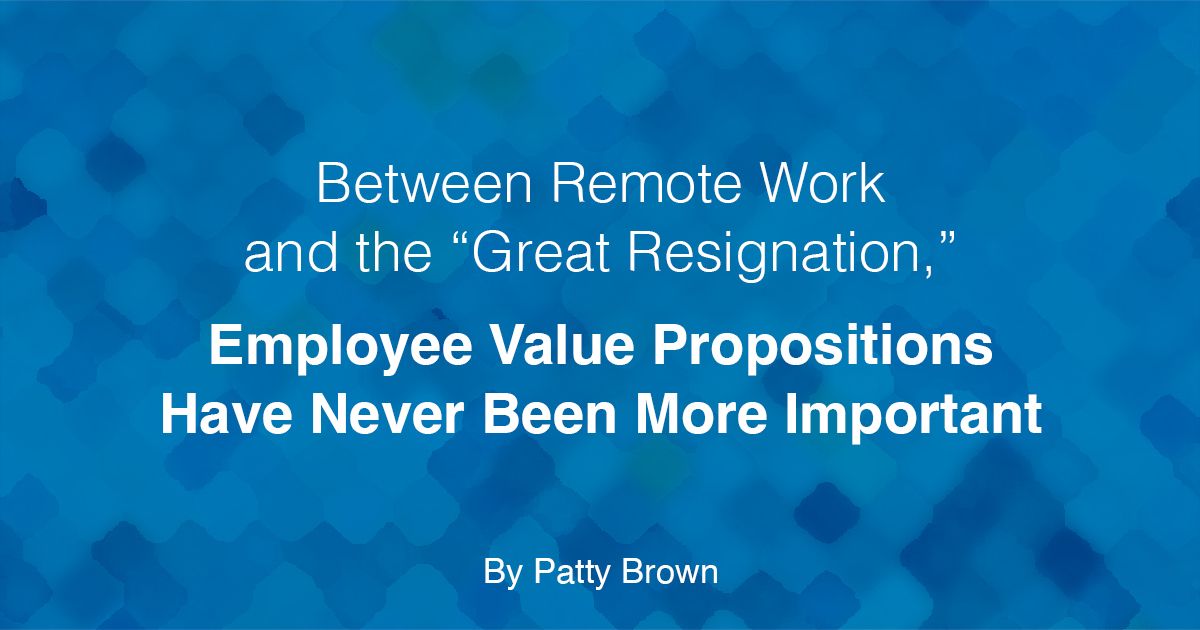I’ve been doing a lot of client brand work lately, and while much of the focus has been on articulating the organization’s externally facing mission, vision, and customer value proposition, the idea of an employee value proposition (EVP) has been coming up a lot more. It’s no wonder: in the era of remote work and the “Great Resignation,” there’s a lot of churn in the job market. EVPs have never been more important and relevant to every employee, from job candidates to tenured employees.
EVPs can be tricky. They don’t always have a natural home or owner. They can fall within the marketing and communications department, or they can fall into the human resources department. There’s no wrong answer as long as it directly contributes to the culture of a team that the organization wants to attract and retain. Getting it right can make a real difference in the long-term prospects of an organization.
According to research firm Gartner, organizations that deliver on their EVP can decrease annual employee turnover by nearly 70% and increase new hire commitment by nearly 30%—extraordinary statistics, particularly when the cost of replacing an individual employee can range from one-half to two times the employee’s annual salary, according to Gallup. Multiply that by the number of people quitting these days and you’re talking big money. According to the U.S Department of Labor, approximately 47 million people voluntarily left their jobs in 2021.
I’m not suggesting a compelling EVP is a cure-all solution. I am suggesting, however, that it doesn’t hurt for employees to understand fully what the organization they’re working for values and why.
The company sweetgreen, a “fast casual” restaurant, offers a terrific EVP model for leaders to evaluate. Although based in Los Angeles now, it was founded in 2007 by three Georgetown students and its first location on M Street in Washington, D.C. was a regular destination for my family and me. It was a fun place to go. The employees enjoyed themselves and they delivered excellent service.
On its website, sweetgreen explains that “we’re leading a movement to reimagine fast food for a new era,” and that the company is “empowering team members to be a positive force in the food system. That’s why we’re building a transparent supply network, why we cook from scratch, and why we’re building a community of people who believe in the power of real food.” These are powerful, motivating messages for sweetgreen’s current and prospective employees.
I like to think of an EVP as a manifestation of how an organizational brand affects employees. Some EVPs focus on benefits like healthcare, childcare, compensation, and PTO, while others may provide details on culture, diversity, and inclusivity.
Whichever benefits you choose to feature in your EVP, think about why your employees come to work every day and assess how your organization can stand out among the growing number of options that employees can choose from. Your EVP should clearly communicate what’s different (and better) about your specific work culture.
Given the close relationship between employee satisfaction and customer satisfaction, organizations that are a force for good in the economy, their communities, and society, would be well advised in making sure their most important stakeholders—employees—get the memo.
Need help developing your organization’s EVP? LMD can help.
Patty is a senior communications and brand strategist with years of experience building and leading global teams for multinational organizations, where she designed and led global campaigns, including brand, thought leadership, media, and sales enablement. She started her career as a journalist, covering technology and business for several leading publishing firms. She has a B.A. in journalism from UNC-Chapel Hill and M.A. in non-fiction writing from Johns Hopkins University.
